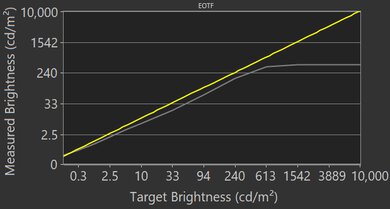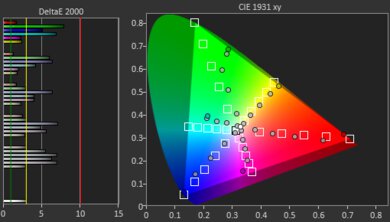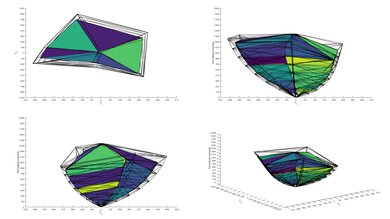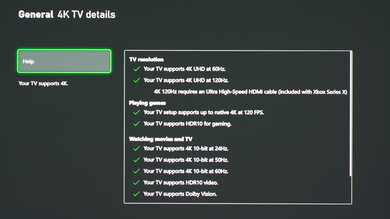The Vizio OLED 2020 is the first OLED TV Vizio has released and delivers excellent overall performance. Like any OLED TV, its ability to turn off individual pixels results in an infinite contrast ratio and perfect black uniformity. It displays an excellent color gamut for HDR content, but it doesn't get very bright in HDR, and large areas get significantly dimmer. Most gamers should appreciate the 120Hz refresh rate, near-instant response time, and low input lag. It has variable refresh rate (VRR) support after a firmware update, but it has some limitations. The TV has a unique center-mounted stand that's designed to hold the Vizio Elevate soundbar. Sadly, the screen has the risk of permanent burn-in, which is typical of OLEDs, and our unit has noticeable temporary image retention, but this may vary between units.
Our Verdict
The Vizio OLED is an excellent TV for most uses. Thanks to its infinite contrast ratio and perfect black uniformity, it's an excellent choice for watching movies in dark rooms. It has wide viewing angles if you want to watch shows or sports with a large group of people. It has a near-instant response time and low input lag for gaming, but 4k @ 120Hz signals skip frames. Unfortunately, there's temporary image retention and risk of permanent burn-in, so it's not ideal for use as a PC monitor.
- Infinite contrast ratio.
- Perfect black uniformity.
- Very wide viewing angles.
- Motion looks very smooth.
- Risk of permanent burn-in.
- 4k @ 120Hz in Game Mode skips frames.
The Vizio OLED is outstanding for watching movies. It displays perfect blacks thanks to its infinite contrast ratio. It upscales 1080p content, such as from Blu-ray players, without any issues, and removes judder from 24p sources. Unfortunately, lower-frame rate content may appear to stutter due to its near-instant response time.
- Infinite contrast ratio.
- Perfect black uniformity.
- Removes judder from 24p sources.
- Lower-frame rate content stutters.
The Vizio OLED is great for watching TV shows. It has very wide viewing angles which is ideal if you tend to walk around while watching TV. It doesn't get extremely bright, but it has incredible reflection handling, so visibility in well-lit rooms shouldn't be a problem. Unfortunately, it has the risk of permanent burn-in that may be an issue if you constantly watch content with static elements, such as the news.
- Incredible reflection handling.
- Very wide viewing angles.
- Upscales lower-resolution content well.
- Doesn't get very bright.
- Risk of permanent burn-in.
The Vizio OLED is impressive for watching sports. It has a near-instant response time that makes motion look very smooth. It has very wide viewing angles, making it ideal for watching the game with a large group of friends. The reflection handling is incredible if you want to place it in a well-lit room, but it doesn't get very bright.
- Incredible reflection handling.
- Very wide viewing angles.
- Motion looks very smooth.
- Doesn't get very bright.
- Risk of permanent burn-in.
The Vizio OLED is great for gaming. It has a near-instant response time and low input lag. It's excellent for dark-room gaming as its OLED panel has an infinite contrast ratio and perfect black uniformity. It has HDMI 2.1 bandwidth, but sadly 4k @ 120Hz signals skip frames in Game Mode.
- Motion looks very smooth.
- Low input lag.
- 4k @ 120Hz in Game Mode skips frames.
The Vizio OLED is excellent for watching HDR movies. It displays perfect blacks thanks to the OLED panel's ability to turn off individual pixels. It also displays an excellent color gamut for HDR content, but it doesn't get extremely bright in HDR, so some highlights may not stand out how they should.
- Infinite contrast ratio.
- Perfect black uniformity.
- Displays wide color gamut.
- Doesn't get very bright.
The Vizio OLED is great for HDR gaming. It has a near-instant response time and low input lag. There's VRR support after a firmware update, but there are some issues with it. HDR content looks excellent because it displays a wide color gamut and has an infinite contrast ratio, but its HDR peak brightness isn't the best.
- Motion looks very smooth.
- Low input lag.
- Displays wide color gamut.
- Doesn't get very bright.
- 4k @ 120Hz in Game Mode skips frames.
The Vizio OLED is great to use as a PC monitor. It has low input lag, and it displays chroma 4:4:4 properly at a 1080p or 4k resolution with a 60Hz refresh rate, which is important for reading text. Sadly, it has the risk of permanent burn-in, and our unit has very noticeable temporary image retention, but this may vary between units.
- Very wide viewing angles.
- Motion looks very smooth.
- Displays chroma 4:4:4 with 60Hz signals.
- Risk of permanent burn-in.
- Our unit has temporary image retention.
Changelog
- Updated Sep 26, 2025: We uploaded the latest brightness measurements and uniformity photos for the Accelerated Longevity Test.
- Updated Jul 08, 2025: We uploaded the latest brightness measurements and uniformity photos for the Accelerated Longevity Test.
- Updated Apr 17, 2025: We uploaded the latest brightness measurements and uniformity photos for the Accelerated Longevity Test.
- Updated Feb 11, 2025: We uploaded the latest brightness measurements and uniformity photos for the Accelerated Longevity Test.
Check Price
Differences Between Sizes And Variants
We tested the 55 inch Vizio OLED and we expect our results to be valid for the 65 inch model as well.
| Size | Model |
|---|---|
| 55" | OLED55-H1 |
| 65" | OLED65-H1 |
If someone comes across a different type of panel or their TV doesn't correspond to our review, let us know and we'll update the review. Note that some tests, such as gray uniformity, may vary between individual units.
You can see our unit's label here.
Popular TV Comparisons
The Vizio OLED is impressive overall; it delivers perfect blacks, and compared to other Vizio TVs we've tested, it doesn't have any issues upscaling lower-resolution content. However, it has too many bugs at launch and its VRR support doesn't actually work. If you don't mind spending a bit more money, the LG BX OLED is a better entry-level option. Also see our recommendations for the best TVs, best OLED TVs, and best Vizio TVs.
The LG CX OLED is better than the Vizio OLED 2020. The LG gets brighter, has much better out-of-the-box color accuracy, much lower input lag, and it has FreeSync support. However, the Vizio has wider viewing angles and slightly better reflection handling.
The LG BX OLED is better than the Vizio OLED 2020. The LG has much better out-of-the-box color accuracy, much lower input lag, it removes judder from any source, and it has FreeSync support. However, the Vizio has much better gradient handling and wider viewing angles.
The Vizio OLED 2020 is somewhat better than the Vizio P Series Quantum X 2020, but they have different panel types. The OLED displays perfect blacks and has much wider viewing angles. It also has better reflection handling, it upscales lower-resolution content well, and has a much quicker response time. However, the Quantum X gets significantly brighter, displays a wider color gamut, has lower input lag, and doesn't have the risk of permanent burn-in.
The Sony A8H OLED is better than the Vizio OLED 2020. Both TVs have an infinite contrast ratio and wide viewing angles. However, the Sony gets brighter, has much better out-of-the-box color accuracy, and Android TV has many more apps available to download. However, the Vizio's reflection handling is slightly better.

We buy and test dozens of TVs yearly, taking an objective, data-driven approach to deliver results you can trust. Our testing process is complex, with hundreds of individual tests that take over a week to complete. Most of our tests are done with specially designed test patterns that mimic real content, but we also use the same sources you have at home to ensure our results match the real-world experience. We use two main tools for our testing: a Colorimetry Research CR-100 colorimeter and a CR-250 spectroradiometer.
Test Results

The Vizio OLED has an incredible design and looks nicer than the LED Vizios we've tested. The main frame is made out of smooth, matte metal, while there's plastic on the back. There's cable management through the stand and panels in the back, and they hide all cables. The stand looks good and raises the TV more than most other stands, so it's good for taller soundbars but you may need more vertical space.
Update 11/04/2020: We incorrectly stated that the back part of the stand can't be removed without removing the front part. You can in fact remove the back part while keeping the front part to hold the soundbar.
The stand is designed to hold the Vizio Elevate soundbar, and even though you can put any soundbar on it, it may not fit perfectly. Also, because of the way it's elevated you need more vertical space than most TVs of its size. If you wall-mount the TV, you can keep the front part of the stand to hold the soundbar and remove the back part, so that the TV sits flush against a will.
Footprint of the 55" TV stand: 21.2" x 10.8".
The top half of the back is smooth metal while the bottom half where the inputs are is textured plastic. You can remove the plastic panels for cable management, and it hides all the loose wires, but the panels are a bit difficult to take off.
Update 11/04/2020: We incorrectly stated that the back part of the stand can't be removed without removing the front part. You can remove the back part while keeping the front part to hold the soundbar, and it allows the TV to sit flush against a wall.
The TV is thin and won't stick out much if you wall-mount it. You can keep the front part of the stand to hold the soundbar and remove the back part if you wall-mount it.
The Vizio OLED has an outstanding build quality. It's well-put-together, and the metal and plastic parts both feel solid. The stand supports the TV well and there isn't much wobble. The glossy part on the back feels cheap, almost like you can take it off. That said, this is only a minor flaw, and there aren't any obvious issues.
Update 03/14/2022: This TV received a firmware update to version 5.41.29.13-1, and it made it a bit brighter in SDR. Most test slides are about 80 nits brighter, but the Real Scene Peak Brightness didn't change much. The new Black Detail setting doesn't do much to improve the brightness.
The Vizio OLED's SDR peak brightness is okay. It gets bright enough to combat some glare but large areas get noticeably more dim due to the aggressive 'Automatic Brightness Limiter' (ABL).
If you leave a static image on the TV for more than five minutes the screen automatically dims itself, and it returns to normal when you press any button on the remote. Unfortunately, there's no setting to control it.
There was a problem with the Peak Luminance setting. If you make any change to it, it resets the screen's brightness to the max, even if you have the Luminance setting at '0'. The brightness returns to normal once you make any adjustment to the Luminance setting.
These results are from after calibration in the 'Calibrated Dark' Picture Mode with Gamma set to '2.2', Color Temperature set to 'Warm', Peak Luminance on 'High', and Luminance at its max. If you want the brightest image possible, use the 'Vivid' Picture Mode with Color Temperature set to 'Cool', Peak Luminance on 'High', and Luminance at its max, as the TV reaches 534 cd/m² with these settings.
Update 07/28/2021: Added the real content local dimming videos.
Since the Vizio OLED doesn't have a backlight, it doesn't have a local dimming feature. It can dim pixels individually, so bright objects and subtitles are displayed perfectly, with no visible blooming.
Update 07/28/2021: Added the real content local dimming videos.
Update 03/14/2022: This TV received a firmware update to version 5.41.29.13-1. Unlike in SDR, the HDR peak brightness in the 'Calibrated Dark' Picture Mode didn't change, but the 'Vivid' mode improved by about 70 nits.
The HDR peak brightness is okay. It makes small highlights pop the way the creator intended, but it quickly loses brightness as large areas cover the screen.
These results are from before calibration in the 'Calibrated Dark' Picture Mode with Gamma set to '2.2', Color Temperature set to 'Warm', Peak Luminance on 'High', and Luminance is at its max by default.
You can get a considerably brighter image of 1,010 cd/m² in the 2% peak window with the Picture Mode set to 'Vivid', Color Temperature set to 'Cool', Luminance on '100', and Peak Luminance on 'High'. After a firmware update it has a new Black Detail setting that's supposed to brighten dark areas of the screen, but it doesn't change the peak luminance.
Update 03/14/2022: This TV received a firmware update to version 5.41.29.13-1, but the HDR brightness in Game Mode didn't change.
The Vizio OLED has okay peak brightness in Game Mode, and it looks exactly like outside of Game Mode.
This TV has excellent gray uniformity, but this may vary between units. There's only minimal dirty screen effect in the center and most people won't notice it. The uniformity is better in near-dark scenes but like most OLEDs, there are some faint vertical and horizontal lines that could be visible in very dark rooms.
Update 12/09/2020: We remeasured the accuracy after calibrating our spectroradiometer. The review has been updated.
Our unit of the Vizio OLED has decent out-of-the-box accuracy, but this may vary between units. Most colors and the white balance are only slightly off. The color temperature is warm, giving the image a red/yellow tint. Luckily, gamma follows the target curve fairly well, but most scenes are slightly over-brightened.
The accuracy after calibration is outstanding. The remaining inaccuracies are hard to spot without the aid of a colorimeter, and the color temperature is extremely close to the 6500K target.
It was difficult calibrating it. We normally calibrate TVs at 100 nits, but even with Luminance and Peak Luminance each set at their minimum, the TV had a brightness of about 120 nits, which affected our calibration. We also encountered a bug where changing the white point value had no effect until we restarted the TV. We couldn't properly calibrate blue because changing the values had no effect.
You can see our recommended settings here.
Unlike other Vizio LED TVs we've tested, such as the Vizio P Series Quantum 2020, the Vizio OLED upscales 480p content well. There aren't any issues.
Update 11/30/2020: For consistency with other reviews, we've replaced the pixel photo with a closer crop.
This TV has an RGBW pixel structure, but all four pixels are never used at the same time. The image above shows the white and blue subpixels, but the blue is considerably darker than the white pixel. You can see the red and green pixels in these pictures: Photo 1 and Photo 2. The way the red and blue pixels are darker than the white pixels is similar to the LG BX OLED.
The Vizio OLED displays an excellent color gamut for HDR content, extremely similar to the LG BX OLED and LG CX OLED. It has near-perfect coverage of the commonly-used DCI P3 color space and decent coverage of the wider Rec. 2020.
Despite having an excellent color gamut, this TV's color volume is only decent. It can't produce extremely bright colors, but with a perfect contrast ratio, it can display dark, saturated colors.
The gradient handling is excellent. Most of the banding is in the grays while other colors have minimal banding. The Noise Reduction and Contour Smoothing settings in the 'Reduce Noise' section don't improve the gradients all that much.
Unfortunately, there's noticeable temporary image retention on our Vizio OLED, but this may vary between units. You may notice static elements even after 10 minutes of disappearing.
During testing, we left the TV on overnight to warm up, and at some point, it displayed the Windows desktop interface until the morning. The interface looked almost burned-in, and even though it cleared up after a while once we restarted it, it's a serious problem if you want to use it as a PC monitor. You can see the image retention here.
This test is only indicative of short term image retention, and not the permanent burn-in that may occur with longer exposure to static images.
Unfortunately, like most OLED TVs, this TV isn't immune to permanent burn-in. However, we don't expect people who watch varied content to have any issues, but rather it's a problem if there are constant static displays, like if it's used as a PC monitor. The Vizio has Pixel Shift and Screen Refresher settings to help reduce this issue.
You can read about our investigation into the possibility of long-term burn-in here.
There's a Black Frame Insertion feature available, but unlike the Vizio P Series Quantum 2020, it only flickers at 120Hz and you may notice image duplication with 60fps content. The setting to control the BFI feature is Clear Action. It works differently than on most TVs, as it only activates when there's movement on the screen. Once movement stops, it returns to a state as if the BFI setting was off.
The Vizio OLED can interpolate motion up to 120fps, known as the 'Soap Opera Effect'. It works decently, as it smooths out motion when there isn't much action, and panning shots look good. However, there are some artifacts when there's a lot of movement, and it creates halos around moving objects and people.
See here for the settings that control the motion interpolation feature.
Due to the near-instant response time, lower frame content appears to stutter. Enabling motion interpolation or the BFI feature can help reduce stutter.
The Vizio OLED removes judder from native 24p sources, such as native apps or Blu-ray players. Simply enable Film Mode for it to work. It can't remove judder from 24p via 60p/i sources and enabling the BFI creates judder in 60p content.
This TV has variable refresh rate support, but there are bugs and issues when using it. FreeSync works with 4k and 1080p signals over its entire refresh rate range, but there's still frame skipping in Game Mode. However, there are issues with FreeSync and 1440p @ 120Hz signals. It's limited between 40-60Hz on the pendulum test demo, and this problem happened with both the RX 580 and RX 6600 XT graphics cards. However, it was tear-free in Destiny 2 with 1440p up to 120Hz. As for its G-SYNC compatibility, once again there weren't any issues with any signal in Destiny 2, but there was tearing in the pendulum test demo until we restarted our laptop. After the restart it was tear-free, and we encountered this problem with 1080p, 1440p, and 4k signals. Overall, it has VRR support, but it doesn't always work properly. If you want an OLED that doesn't have any bugs with its VRR support, consider the LG B2 OLED.
Update 03/14/2022: This TV received a firmware update to version 5.41.29.13-1, which is advertised to improve the 4k @ 120Hz compatibility. Sadly, even after the update 4k @ 120Hz still skips frames in Game Mode, so we couldn't get a proper input lag measurement. However, with VRR enabled it doesn't skip frames, but we still couldn't get a proper reading as this is an issue we've experienced with other TVs, and we're looking into it.
The Vizio OLED has low input lag, but it's higher than other TVs and not ideal for competitive gamers. You need to be in 'Game' mode to achieve the lowest input lag possible.
There were some bugs in Game Mode during testing, similar to the Vizio P Series Quantum 2020. The TV skips frames with 120Hz content on any resolution in Game Mode, except for 1080p @ 120Hz, so we couldn't test the input lag for it. This TV has VRR support, but there are a bunch of issues, so we couldn't measure its input lag properly.
Update 03/14/2022: This TV received a firmware update to version 5.41.29.13-1, but it didn't change anything with the supported resolutions. 4k @ 120Hz still works fine outside of Game Mode, but it skips frames in Game Mode. Text still looks blurry with 4k @ 120Hz signals with chroma 4:4:4, as you can see here.
Update 07/28/2021: We retested 4k @ 120Hz support with the latest firmware and found that it still can't display 4k @ 120Hz properly in Game Mode, but the exact issue varies from one PC to another. With an RTX 3080, it didn't accept 4k @ 120Hz at all, doing so would cause the screen to go black. From an RTX 3070, it displays properly, but only with the color format set to RGB, as YCbCr444 caused the screen to freeze. 4k @ 120Hz skips frames if Game Low Latency is enabled. With that setting disabled it doesn't skip frames, but it can't display text properly either, even when sending RGB.
Update 05/19/2021: With the latest firmware 5.10.15.12-1, 1080p @ 120Hz now works properly without skipping any frames with 'Game Low Latency' enabled. It now supports 1440p @ 60Hz, but 1440p @ 120Hz still skips frames.
This TV supports most common resolutions up to 120Hz. It also displays proper chroma 4:4:4 with any resolutions at 60Hz, but not at 120Hz. You have to set your PC to 'RGB' and not 'Chroma 4:4:4' because 'Chroma 4:4:4' looks bad. With the PC set to 'RGB', the TV grays out the Full Color 4:4:4 option.
Update 03/14/2022: This TV received a firmware update to version 5.41.29.13-1, and it now supports 1440p @ 120Hz signals from the Xbox Series X. However, you need to disable the Allow 4k setting in the Xbox menu for it to be proper 1440p, otherwise it will upscale to 4k.
This TV supports all common resolutions from the Xbox Series X and PS5. Even if it supports 4k @ 120Hz signals from either console, it skips frames once you enable the Game Mode, so it's useless to play 4k @ 120Hz games.
Update 03/14/2022: This TV received a firmware update to version 5.41.29.13-1. It supports the full 48 Gbps bandwidth of HDMI 2.1 as it accepts 4k @ 120Hz signals with chroma 4:4:4 and 12-bit color depth.
While Vizio advertises all ports as being HDMI 2.1, only HDMI 2 and HDMI 3 support 4k @ 120Hz.
There's eARC support, allowing you to send high-quality audio over a HDMI connection. For it to work, enable eARC and set Digital Audio Out either to 'Auto' or 'Digital'. During testing, it worked at times with it set to 'Auto' and other times with it set to 'Digital'.
The Vizio OLED has an okay frequency response. It gets very loud but there's compression at its max volume. It doesn't produce much of a bass either and you won't hear any rumble or thump.
This TV has decent distortion performance. There's hardly any distortion at moderate listening levels but it gets a lot more noticeable at its max volume. However, this varies depending on its content and some people may not hear it.
Update 11/11/2020: The SmartCast version was incorrectly listed as version 1.60, when it's in fact version 1.40.
The Vizio SmartCast system is decent. It's easy-to-use and fairly smooth to navigate. However, we encountered many bugs during testing that are mentioned above, and the SmartCast system crashes at times. If you want an OLED with a more reliable smart interface, check out the LG C1 OLED.
There's a decent number of apps that come pre-installed, but sadly, you can't download any extra. Luckily, you can cast anything you want from your mobile device. If you prefer an OLED whose interface features an app store, then look into the LG B1 OLED.
The Vizio OLED comes with the same simple remote as other Vizio TVs. There are shortcut buttons to popular streaming services, but there's no voice control. However, you can use the dedicated app or connect the TV to your Google Home for voice control. If you want a TV that comes with a remote with voice control, the Sony A80K/A80CK OLED is a good alternative.




















































